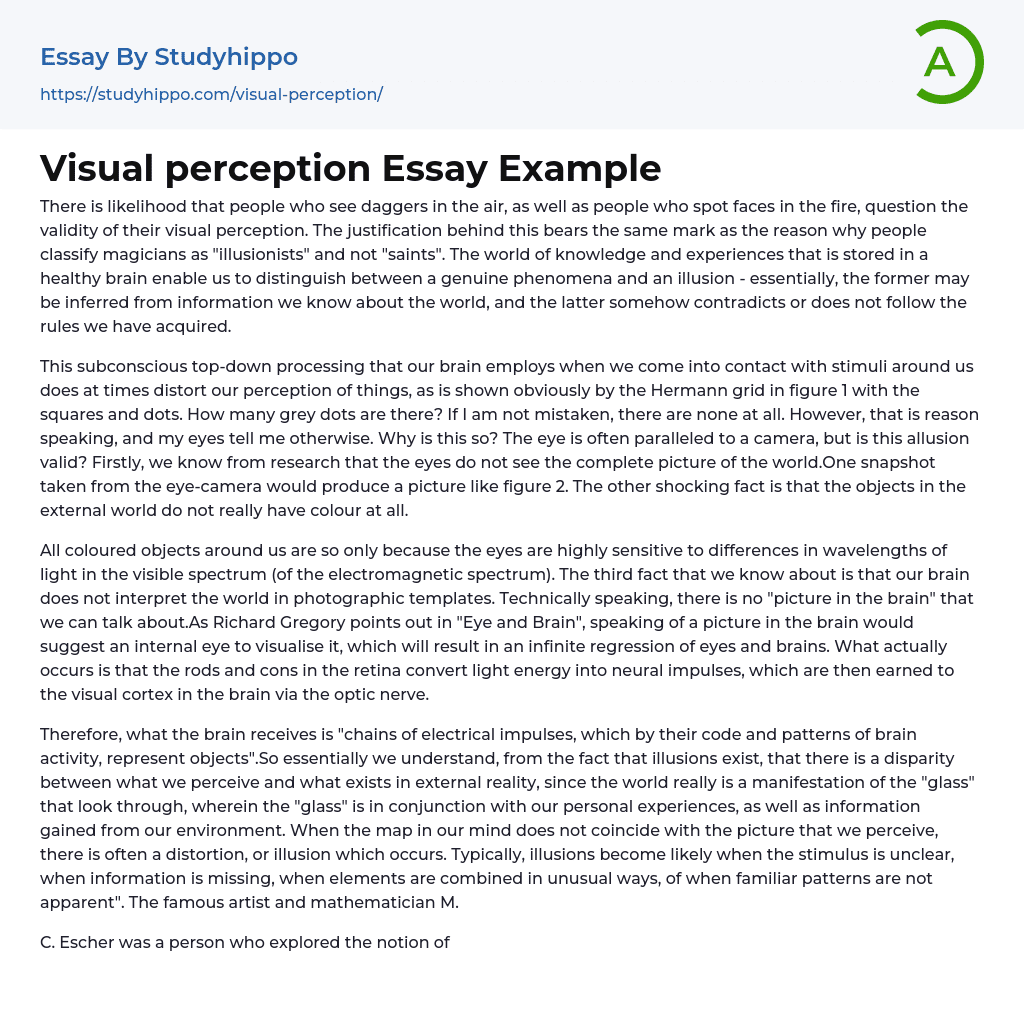It is possible that individuals who observe daggers in the surroundings and those who identify faces in flames may doubt the accuracy of their sight. The rationale for this is akin to why individuals categorize magicians as "illusionists" rather than "saints." A healthy brain's repository of knowledge and experiences administers our ability to differentiate between a genuine event and an illusion - fundamentally, the former can be deduced from our understanding of the world, whereas the latter contradicts or does not comply with established principles.
This article explores the subconscious top-down processing of stimuli in our brain and how it can distort our perception, as demonstrated by the Hermann grid (figure 1) with its squares and dots. Despite the appearance of grey dots, there are actually none, as reason tells us. However, our eyes may see otherwise. W
...hile often compared to a camera, research shows that the eyes do not capture a complete picture of the world. Figure 2 illustrates what one snapshot from the "eye-camera" might produce. Additionally, objects in the external world don't truly have color.
The reason why objects around us appear in different colors is due to the eyes' sensitivity to varied wavelengths of light in the visible spectrum within the electromagnetic spectrum. Additionally, it is important to note that the brain does not interpret the world as visual templates. Richard Gregory aptly pointed out that discussing pictures in the brain would imply an internal eye visualizing it, leading to endless regressions of eyes and brains. Instead, the rods and cones in the retina convert light energy into neural impulses, which travel through the optic nerve to the visual cortex in the brain.
Therefore,
the brain receives "chains of electrical impulses" that represent objects based on their code and patterns of brain activity. Illusions exist because there is a disparity between what we perceive and the external reality. The world is a manifestation of the "glass" we look through, shaped by our experiences and environmental information. When our mental map does not coincide with what we perceive, illusions occur, often due to unclear stimuli, missing information, unusual element combinations, or unfamiliar patterns. The notable artist and mathematician M.
C. Escher explored the concept of ambiguous stimuli and depicted it in his famous artwork, Ascending and Descending (check Figure 3). In this artwork, people at the top of the building seem to move up or down continuously, even though they don't actually go higher or lower in the end. The reason behind this visual illusion is that Path C is ambiguous, and points A and B are of similar heights. Escher manipulates these conditions to create a staircase that appears to be continuously ascending or descending.
The importance of painters like Escher and Dali lies in their subjectivity and relativity, rather than in their impressionistic ability to depict the world. Their art raises the question of whether our sensory interpretation of the world is the only reality. While this cannot be refuted, it is still important to explore and understand the sensory world we perceive, as well as the nature of illusions and ambiguous stimuli. By understanding how our eyes work, we can begin to explain why we see alternating and non-fixed black dots in phenomena such as the Hermann grid.
The Hermann Grid effect and the darker appearance of
pink boxes surrounded by green boxes are both caused by receptor cells in the retina inhibiting adjacent cells when they fire. This results in dark dots outside our focus and a visual illusion in the diagram shown in Figure 5.
The way our eyes interpret information in our environment is similar to how they perceive two simultaneous dark colors that involve receptor cells, as illustrated in the Hermarin grid. This phenomenon applies to everyday situations, like how a black dress can make a woman appear slimmer than wearing a white one or how red walls can make a house seem smaller than pale yellow ones. The perception of brightness and the presence or absence of light are crucial factors in these cases. Illusions are prevalent in our daily lives - from seeing shapes like dragons in clouds or humanoid trees - to identifying faces on Mars or in fire (figure 6). However, even though these shapes may resemble certain entities, we rarely believe that they embody them.
Our cognitive abilities do not inherently allow us to differentiate between whether our curtains have a life or if David Blame can actually fly. The ability to distinguish these concepts, however, is possible through our life experiences and interactions with the world around us. Science has contributed to this understanding through ongoing research and exploration. We must recognize that the idea of a dagger in the air only exists in our minds; it is not a physical reality.
- Action Potential essays
- Blood essays
- Body essays
- Brain essays
- Childbirth essays
- Eye essays
- Glucose essays
- Heart essays
- Human Physiology essays
- Immune System essays
- Kidney essays
- Muscle essays
- Nervous System essays
- Neuron essays
- Poison essays
- Puberty essays
- Sense essays
- Skeleton essays
- Skin essays
- Consciousness essays
- Intelligence essays
- Mindset essays
- Perception essays
- Problem Solving essays
- Resilience essays




